Topics
Category
Era
Treaty of Mendota, 1851
Oil-on-canvas painting depicting a view of Mendota from Fort Snelling, 1848. Painting by Seth Eastman.
The Treaty of Mendota was signed by the Mdewakanton and Wahpekute bands of Dakota and the US government in 1851. By signing it and the Treaty of Traverse des Sioux the same year, the Dakota transferred ownership of much of their lands to the United States. The two treaties opened millions of acres to white colonization, but for the Dakota, they were a step towards the loss of their homeland and the US–Dakota War of 1862.
By 1849 there was great demand for the lands of the Dakota to be acquired by the United States. The white population of Minnesota Territory had not outgrown the lands acquired from the Dakota in the 1837 Treaty, but some colonists had begun squatting on unceded Dakota lands. A tide of western migration was close at hand, and the Dakota lands were attractive to land speculators. Territorial Governor Alexander Ramsey began to push for a new treaty in 1849. He was aided in his efforts by territorial delegate and trader Henry Sibley. The Dakota owed Sibley, and other traders, a great deal of money. Ramsey, and his fellow commissioner Luke Lea, represented the United States Government in the treaty process. Sibley rallied the numerous traders and attempted to exert his influence upon the Dakota.
First, the treaty delegation traveled to Traverse des Sioux and negotiated a treaty with the upper bands of the Dakota which included the Wahpeton and Sisseton. The Treaty of Traverse des Sioux was signed July 23, 1851. The vast majority of the chiefs also signed a trader's paper, which directed the government to first pay debts claimed by traders using the money promised to the upper bands. Afterward the treaty delegation traveled to Mendota to meet with the two lower bands of the Dakota, the Mdewakanton and Wahpekute.
The negotiations began on July 29, 1851 in one of Sibley's warehouses. They then moved to Pilot Knob where an arbor was erected. The Mdewakanton and Wahpekute were in a stronger position than the upper bands when it came to negotiations. They were not as desperate for food and goods. Further, the Mdewakanton had learned much from the Treaty of 1837. However, the treaty commissioners pointed out that with the sale of the upper bands' land, the Mdewakanton and Wahpekute would be surrounded by white colonists, and eventually forced to give up their land.
Led by Ta Oyate Duta (His Red Nation, also known as Little Crow IV) and Wabasha III, the Dakota asked that an annuity from the 1837 treaty be paid before there was any further discussion. The bands also tried to change the boundaries of the proposed reservation. These issues stalled the negotiations until August 5, 1851. It was agreed that $30,000 would be paid to the Dakota immediately in place of the 1837 annuity. The commissioners stated that the reservation borders were not negotiable. Many of the younger tribal leaders threatened their senior chiefs with death if they signed. Even so, Ta Oyate Duta stood and boldly signed the treaty followed by Wabasha III and sixty-three other leaders.
Sibley tried to get the Mdewakanton and Wahpekute to sign traders' papers, but both bands initially refused. Eventually, in November 1851, leaders from the two bands did so. Some sources suggest that tribal leaders and their agents were bribed into signing the papers. The Wahpekute agreed to pay traders $90,000. The Mdewakanton paid $70,000 and were given $20,000 which was shared between seven chiefs. Five Dakota men were also released from the jail at Fort Snelling when the papers were signed. The Treaty of Mendota stated that there would always be friendship between the Dakota and United States Government. The Dakota were to receive $1,410,000 for their land, most of which would be held in trust and paid in annual annuities.
The treaties with the Dakota were approved by Congress, with some changes, on June 23, 1852. Forty-five chiefs of the lower bands signed the treaty on September 4, 1852. With the treaty, Ramsey and other government officials accomplished one of their greatest goals. Sibley and the traders received some money, though not all of the Dakota's debts were paid. The Dakota ceded much of their homeland with the treaties of 1851, and began living on reservations, which was a permanent change to their way of life.
Bibliography
M203, M203-A, M204, P824, +77
Alexander Ramsey and Family Personal Papers and Governor's Records, 1829–1965
Manuscript Collection, Minnesota Historical Society, St. Paul
Description: Correspondence, records, and government papers, documenting the career of Ramsey and his family
M164
Henry H. Sibley Papers, 1815–1932.
Manuscript Collection, Minnesota Historical Society, St. Paul
http://www2.mnhs.org/library/findaids/00595.xml
Description: Correspondence, records, legal papers, and speeches of Henry H. Sibley.
Treaties concluded by the United States with the Sioux Indians: Traverse des Sioux, July 23, 1851 and Mendota, August 5, 1851. Boston: Little, Brown and Company, 1853.
Anderson, Gary Clayton. Kinsmen of Another Kind: Dakota-White Relations in the Upper Mississippi Valley, 1650–1862. St. Paul: Minnesota Historical Society Press, 1997.
Folwell, William Watts. A History of Minnesota, Vol. I. St. Paul: Minnesota Historical Society Press, 1956. First published in 1921 by Minnesota Historical Society Press.
Gilman, Rhoda R. "Territorial Imperative: How Minnesota Became the 32nd State." Minnesota History 56, no. 4 (Winter 1998): 154V171.
http://collections.mnhs.org/mnhistorymagazine/articles/56/v56i04p154-171.pdf
Snyder, Rebecca, ed. The 1851 Treaty of Mendota: A Collection of Primary Documents Pertaining to the Treaty. South St. Paul: Dakota County Historical Society, 2002.
Related Resources
Primary
A/-E95
William G. Ewing and George W. Ewing papers, 1847–1882
Manuscripts Collection, Minnesota Historical Society, St. Paul
Description: This collection contains typewritten copies of letters regarding payments to fur traders after the Treaty of Traverse des Sioux.
Mayer, Frank Blackwell. With Pen and Pencil on the Frontier in 1851: The Diaries and Sketches of Frank Blackwell Mayer. Bertha L. Heilbron, ed. St. Paul: Minnesota Historical Society Press, 1986.
P643
Frank B. Mayer papers, 1851–1903
Manuscripts Collection, Minnesota Historical Society, St. Paul
Description: This collection contains copies from a diary kept by Mayer during his travels around the time of the Treaty. An artist, Mayer produced paintings of the treaty signing, which he witnessed.
M45
Materials Relating to the 1851 Dakota Treaties, 1849–1952
Manuscripts Collection Microfilm, Minnesota Historical Society, St. Paul
Description: A microfilm copy of materials held by the National Archive, it includes copies of the treaty, the treaty commission's journal, correspondence between treaty commissioners and the federal government, as well as a report by the commissioners.
M24
Hercules L. Dousman Papers, 1848–1853
Manuscripts Collection Microfilm, Minnesota Historical Society, St. Paul
Description: This collection mostly holds the correspondence of Dousman, a Wisconsin fur trader and land speculator. Some letters concern the treaty negotiations.
"The Sioux Treaty." Minnesota Pioneer, August 7, 1851.
"The Sioux Treaty." Minnesota Pioneer, August 14, 1851.
The Treaty with the Sioux." Minnesota Pioneer, October 27, 1853.
Secondary
Anderson, Gary Clayton. Little Crow: Spokesman for the Sioux. St. Paul: Minnesota Historical Society Press, 1986.
Gilman, Rhoda R. Henry Hastings Sibley: Divided Heart. St. Paul: Minnesota Historical Society Press, 2004.
Kane, Lucille M. "The Sioux Treaties and the Traders." Minnesota History 32, no. 2 (June, 1951): 65–80.
http://collections.mnhs.org/MNHistoryMagazine/articles/32/v32i02p065-080.pdf
Thompson, Ruth. "The Sioux Treaties at Traverse des Sioux and Mendota in 1851 and their Outcome." Masters dissertation, University of Minnesota, 1912.
Westerman, Gwen, and Bruce White. Mni Sota Makoce: The Land of the Dakota. St. Paul: Minnesota Historical Society, 2012.
Woolworth, Alan R. and Nancy L. The Treaty of Mendota August 5, 1851 between the United States and the Mdewakanton and Wahpekute Dakota Indian Tribes: An Historical Examination. White Bear Lake, MN: Woolworth Research Associates, 1982.
Web
Minnesota Historical Society, Minnesota Treaties. The US-Dakota War of 1862
https://www3.mnhs.org/usdakotawar/stories/history/treaties/minnesota-treaties
Treaties Matter. Relations: Dakota and Ojibwe Treaties
http://treatiesmatter.org/treaties/land/1851-Dakota
John Labatte, interviewed by Deborah Locke. U.S.-Dakota War Oral Histories, Minnesota Historical Society, St. Paul, May 31, 2011.
http://collections.mnhs.org/cms/display.php?irn=11007768&websites=no&q=Treaty%20of%20Mendota&type[]=Oral%20histories&startindex=1&count=25
Walter LaBatte, interviewed by Deborah Locke. U.S.-Dakota War Oral Histories, Minnesota Historical Society, St. Paul, April 28, 2011.
http://collections.mnhs.org/cms/display.php?irn=11007770&websites=no&q=Treaty%20of%20Mendota&type[]=Oral%20histories&startindex=1&count=25
Related Images
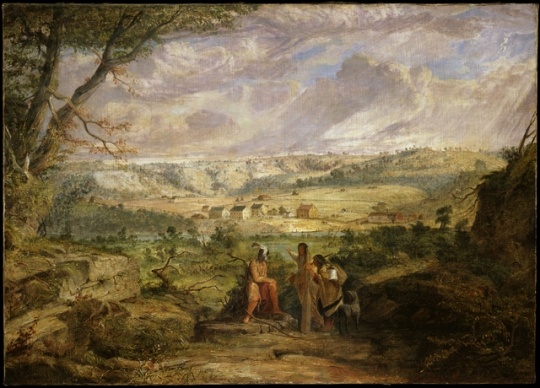
Mendota from Fort Snelling
Oil-on-canvas painting depicting a view of Mendota from Fort Snelling, 1848. Painting by Seth Eastman.
Public domain
Holding Location
More Information
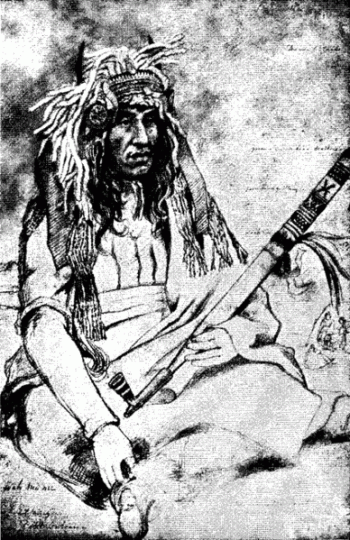
Taoyateduta (Little Crow IV)
Dakota Leader Taoyateduta (Little Crow IV) sketched at Traverse des Sioux, Minnesota Territory, in 1851 by artist Frank Blackwell Mayer.
Public domain
More Information
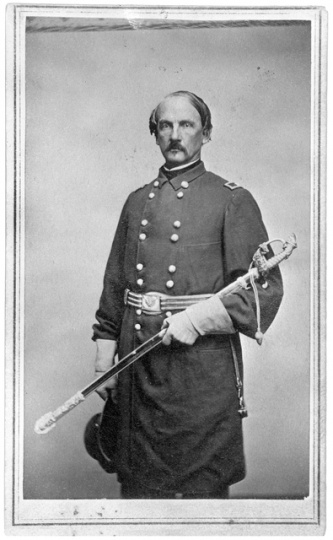
Henry H. Sibley, brigadier general
Henry H. Sibley as a brigadier general in the United States Volunteer Army, 1863.
Holding Location
More Information
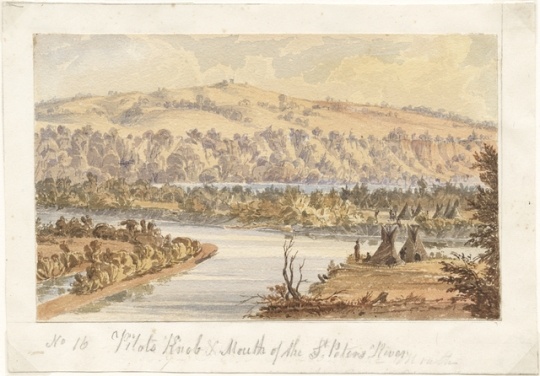
Pilot Knob Mouth of the St. Peters River
Pilot Knob, c.1846–1848, where the Treaty of Mendota was signed on August 5, 1851.
Public domain
Holding Location
Articles
More Information
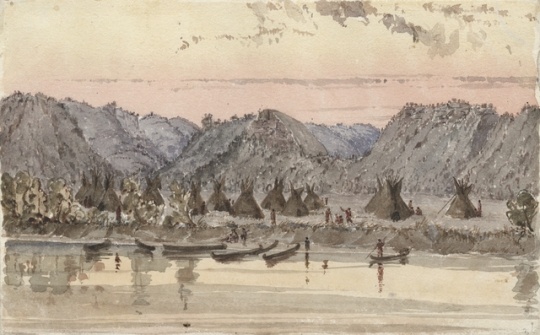
Dakota Leader Wahbasha's Village on the Mississippi River
Wabasha's village, c.1845 on lands which were ceded to the United States by the Treaty of Mendota.
Public domain
Holding Location
Articles
More Information

Taoyateduta's (Little Crow IV) Village on the Mississippi
Taoyateduta's (Little Crow IV) village, c.1846–1848 on lands which were ceded to the United State by the Treaty of Mendota.
Public domain
Holding Location
Articles
More Information
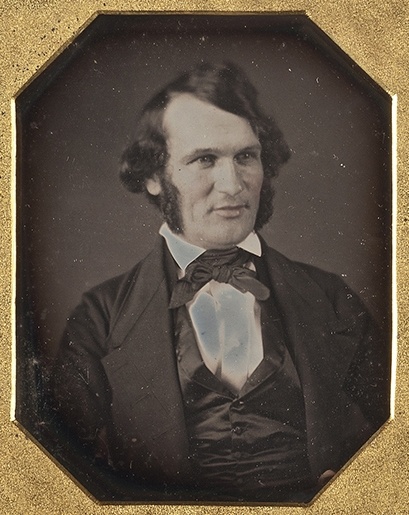
Alexander Ramsey
Alexander Ramsey, ca. 1848.
Public domain
Holding Location
More Information
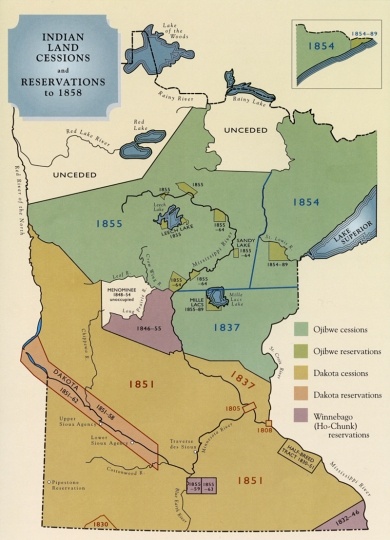
Native American Land Cessions and Reservations to 1858
Map of the lands within Minnesota Territory ceded by Native Americans by 1858. Created by Alan Ominsky ca. 1999. Reproduced in Making Minnesota Territory, 1849–1858 (St. Paul: Minnesota Historical Society Press, 1999), page 7.
Holding Location
Related Articles
Turning Point
Signed on August 5, 1851, the Treaty of Mendota cedes the lands of the Mdewakanton and Wahpekute bands of the Dakota to the United States in exchange for annuity payments and a reservation on the Minnesota River.
Chronology
1805
1837
July 23, 1851
July 29, 1851
August 5, 1851
November, 1851
June 23, 1852
September 4, 1852
1862
Bibliography
M203, M203-A, M204, P824, +77
Alexander Ramsey and Family Personal Papers and Governor's Records, 1829–1965
Manuscript Collection, Minnesota Historical Society, St. Paul
Description: Correspondence, records, and government papers, documenting the career of Ramsey and his family
M164
Henry H. Sibley Papers, 1815–1932.
Manuscript Collection, Minnesota Historical Society, St. Paul
http://www2.mnhs.org/library/findaids/00595.xml
Description: Correspondence, records, legal papers, and speeches of Henry H. Sibley.
Treaties concluded by the United States with the Sioux Indians: Traverse des Sioux, July 23, 1851 and Mendota, August 5, 1851. Boston: Little, Brown and Company, 1853.
Anderson, Gary Clayton. Kinsmen of Another Kind: Dakota-White Relations in the Upper Mississippi Valley, 1650–1862. St. Paul: Minnesota Historical Society Press, 1997.
Folwell, William Watts. A History of Minnesota, Vol. I. St. Paul: Minnesota Historical Society Press, 1956. First published in 1921 by Minnesota Historical Society Press.
Gilman, Rhoda R. "Territorial Imperative: How Minnesota Became the 32nd State." Minnesota History 56, no. 4 (Winter 1998): 154V171.
http://collections.mnhs.org/mnhistorymagazine/articles/56/v56i04p154-171.pdf
Snyder, Rebecca, ed. The 1851 Treaty of Mendota: A Collection of Primary Documents Pertaining to the Treaty. South St. Paul: Dakota County Historical Society, 2002.
Related Resources
Primary
A/-E95
William G. Ewing and George W. Ewing papers, 1847–1882
Manuscripts Collection, Minnesota Historical Society, St. Paul
Description: This collection contains typewritten copies of letters regarding payments to fur traders after the Treaty of Traverse des Sioux.
Mayer, Frank Blackwell. With Pen and Pencil on the Frontier in 1851: The Diaries and Sketches of Frank Blackwell Mayer. Bertha L. Heilbron, ed. St. Paul: Minnesota Historical Society Press, 1986.
P643
Frank B. Mayer papers, 1851–1903
Manuscripts Collection, Minnesota Historical Society, St. Paul
Description: This collection contains copies from a diary kept by Mayer during his travels around the time of the Treaty. An artist, Mayer produced paintings of the treaty signing, which he witnessed.
M45
Materials Relating to the 1851 Dakota Treaties, 1849–1952
Manuscripts Collection Microfilm, Minnesota Historical Society, St. Paul
Description: A microfilm copy of materials held by the National Archive, it includes copies of the treaty, the treaty commission's journal, correspondence between treaty commissioners and the federal government, as well as a report by the commissioners.
M24
Hercules L. Dousman Papers, 1848–1853
Manuscripts Collection Microfilm, Minnesota Historical Society, St. Paul
Description: This collection mostly holds the correspondence of Dousman, a Wisconsin fur trader and land speculator. Some letters concern the treaty negotiations.
"The Sioux Treaty." Minnesota Pioneer, August 7, 1851.
"The Sioux Treaty." Minnesota Pioneer, August 14, 1851.
The Treaty with the Sioux." Minnesota Pioneer, October 27, 1853.
Secondary
Anderson, Gary Clayton. Little Crow: Spokesman for the Sioux. St. Paul: Minnesota Historical Society Press, 1986.
Gilman, Rhoda R. Henry Hastings Sibley: Divided Heart. St. Paul: Minnesota Historical Society Press, 2004.
Kane, Lucille M. "The Sioux Treaties and the Traders." Minnesota History 32, no. 2 (June, 1951): 65–80.
http://collections.mnhs.org/MNHistoryMagazine/articles/32/v32i02p065-080.pdf
Thompson, Ruth. "The Sioux Treaties at Traverse des Sioux and Mendota in 1851 and their Outcome." Masters dissertation, University of Minnesota, 1912.
Westerman, Gwen, and Bruce White. Mni Sota Makoce: The Land of the Dakota. St. Paul: Minnesota Historical Society, 2012.
Woolworth, Alan R. and Nancy L. The Treaty of Mendota August 5, 1851 between the United States and the Mdewakanton and Wahpekute Dakota Indian Tribes: An Historical Examination. White Bear Lake, MN: Woolworth Research Associates, 1982.
Web
Minnesota Historical Society, Minnesota Treaties. The US-Dakota War of 1862
https://www3.mnhs.org/usdakotawar/stories/history/treaties/minnesota-treaties
Treaties Matter. Relations: Dakota and Ojibwe Treaties
http://treatiesmatter.org/treaties/land/1851-Dakota
John Labatte, interviewed by Deborah Locke. U.S.-Dakota War Oral Histories, Minnesota Historical Society, St. Paul, May 31, 2011.
http://collections.mnhs.org/cms/display.php?irn=11007768&websites=no&q=Treaty%20of%20Mendota&type[]=Oral%20histories&startindex=1&count=25
Walter LaBatte, interviewed by Deborah Locke. U.S.-Dakota War Oral Histories, Minnesota Historical Society, St. Paul, April 28, 2011.
http://collections.mnhs.org/cms/display.php?irn=11007770&websites=no&q=Treaty%20of%20Mendota&type[]=Oral%20histories&startindex=1&count=25









